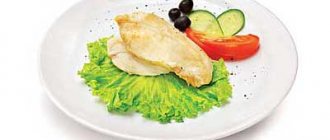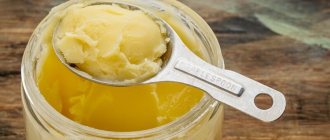How many calories are in a 2 egg omelette with milk?
The calorie content of 100 grams of an omelet made from two eggs is 172 kcal. That is, the calorie content of an omelet made from two eggs increases by the energy value of one egg (approximately).
After such a simple conclusion, it is easy to answer the question: “How many calories are in an omelet of 3 eggs with milk?” - 216 kcal.
You can reduce the calories in this omelet recipe by replacing the milk with water. After all, the calorie content of an omelet with milk is much higher than that of a cooked product with water.
And then the admirer of chicken eggs will not ask the question that is framed in the subtitle, but only: “How many calories are in an omelet made from 2 eggs?”
Below we will look at ways to reduce the calorie content of an omelet made from 2 yolks and 3 whites of eggs with milk.
The benefits of omelet for weight loss
A dish made only from eggs with a small addition of low-fat milk can be called one of the most successful food options for weight loss supporters.
The benefits of eggs include the inclusion in the composition of a chicken egg:
- Vitamin A necessary for immunity, optimal condition of skin, hair and nails
- B vitamins that are beneficial for the immune system and nervous system.
- Vitamins of group D that promote natural vasodilation.
- Vitamin E, ready to heal wounds and strengthen the walls of blood vessels.
Good to know! This product also contains a large number of microelements and nutrients. Including magnesium, sodium, folic acid, iron, iodine and other components. Lutein helps break down bad cholesterol.
How many calories are in an omelet with tomatoes?
The calorie content of an omelet with tomatoes increases by the energy value of vegetables: 100 g of tomato – 30 kcal. An omelet with tomatoes produces more liquid, which can be removed in various ways.
Tomatoes, bell peppers, pre-fried onions can be placed:
- In an omelette with sausage;
- In an omelette with ham;
- In an omelette with sausage;
- In an omelet with cheese, lard and other products with a high degree of fat content.
Nutritionists rightly believe that, taking into account the quality of modern sausage and dairy products, it is better to dilute an omelet with vegetables with “good” water, fry in vegetable (olive) oil, without any meat additives at all, sprinkle the finished product with various herbs (dill, parsley , basil). To reduce the energy value of an omelet, you can remove the yolk from the eggs by adding a certain amount of flour to the omelet (exactly how much depends on the person’s culinary preferences).
The most useful omelet recipes
After figuring out the calorie content of an omelet, people who follow a healthy diet will definitely want to know how to reduce it without sacrificing taste and quality. So, the first and most important thing is to stop frying. Yes, a crispy crust is wonderful, but it is also carcinogenic and can increase the load on the liver. Given that eggs are already the leader among other products with the last point, you shouldn’t tempt fate once again. It is better to give preference to an oven, multicooker or double boiler.
An elementary comparison: the calorie content of an omelet made from eggs, milk, onions, tomatoes and pork ham in a slow cooker will be 130 kcal per 100 g, while in a frying pan the same mixture will already “weigh” 198 kcal at best.
Second: it is worth adding greens to the omelet. Parsley, dill, basil - these small branches are excellent fighters against excess fat, and also work excellently to protect the health of the gastrointestinal tract. And you should choose not dried options, but fresh ones, if possible.
Third: the calorie content of an omelet made from eggs is higher than the calorie content of an omelet made from proteins alone. 130 kcal versus 85 kcal is still a noticeable difference. This is due to the fact that the heaviest and fattest part of the egg is the yolk. Moreover, by removing it, you can get a dish that is light in every sense: not only in terms of calorie content, but also in terms of its consistency. The omelette will turn out airy and tender if the whites are fresh, cold and form a strong foam.
Fourth: few people know that counting calories, an omelette can be prepared... using “table” mineral water. Yes, the taste will be somewhat peculiar, but this is a matter of habit. But such a magnificent option will not work in any other combination.
If we talk about the filling, then in addition to the ingredients themselves, which “set the tone” for the caloric content of the dish, it would not be amiss to remember about the method of their preparation. If vegetables can still be thrown raw, then, for example, this will not work with meat. It is advisable to choose chicken or turkey, boil it first, and then add it to the mixture. Otherwise, in terms of the number of calories, an omelet prepared with steamed pork will be comparable to an omelet with fried poultry added.
Omelet is a popular dish made from eggs, milk and various additional ingredients that make it a gourmet meal. At the same time, many people are interested in how many calories are in an omelet with milk. In this article we will look at this issue, and also analyze the nutritional value, benefits and harms of egg dishes.
How many calories are in an omelette without yolk?
An omelette with vegetables without yolks (100 g) contains:
- Proteins – 7.6 g;
- Fat – 8.2 g;
- Carbohydrates – 2.6 g;
- The calorie content of the product is 111 kcal.
For many people, such an omelet recipe loses its taste, but the choice is up to the consumer: either food with less calories, or the taste of the product. In an omelet with vegetables, the absence of yolks in the product will not be so noticeable, since each vegetable brings its own individual “notes” to the dish.
Do you want to lose excess weight?
A slim figure is the dream of many women and men. I want to be at a comfortable weight without exhausting myself with strict diets and heavy exercises.
In addition, excess weight can lead to health problems! Heart disease, shortness of breath, diabetes, arthritis and significantly reduced life expectancy!
It has the following properties:
- Speeds up metabolism
- Burns fat deposits
- Reduces weight
- Lose weight even with minimal physical activity
- Helps reduce weight in cardiovascular diseases
Ways to reduce the calorie content of an omelet
- We prepare the product using household appliances. An omelet in a slow cooker or double boiler has slightly fewer calories. Naturally, such an omelette will not have the delicious crust that many people love;
- We reduce the number of eggs in the omelet to a reasonable limit and add various vegetables, herbs, do not use mayonnaise and ketchup;
- We prepare the omelette without yolks, using high-quality water (melt). Any lazy person who has a refrigerator with a freezer can prepare melt water;
- We prepare an omelette without using any oil (even the “favorite” of all nutritionists, olive oil).
What are the benefits of an omelet?
This dish is not always consumed as a breakfast; it can easily be a complement to lunch or an excellent snack. The omelet contains vitamins A, E, D, B6, B12. Many children adore it and this is great, because thanks to the calcium and selenium contained in the dish, the child’s body develops and his immune system is strengthened.
Today there is already scientific evidence that an omelet can relieve headaches and muscle pain and even strengthen the nervous system. You can’t call this delicacy a panacea, but the omelette has many benefits for the body. Just look at the high calcium content, which strengthens bones, nails, and teeth.
How many calories are in an omelet without butter?
Calorie content of 100 grams of various oils with which most people prepare omelettes:
- Olive – 198 kcal;
- Sunflower – 578 kcal;
- Creamy – 748 kcal;
- Peanut and corn - 899 kcal each.
We remove 20 - 30 grams of oil from the recipe, and we get a significant saving in kilocalories consumed. Of course, you won’t be able to fry an omelette in a frying pan on a gas stove without any oil, but preparing a delicious product in the oven or slow cooker is easy and simple. You can also cook an omelet without oil in the microwave, but...
In our opinion, an omelette in the oven gives a special taste, because the product is cooked not only from below, as on a gas stove, but also from above. We are sure that most “second” dishes baked in the oven or multicooker are much tastier than those cooked on a gas stove.
In our opinion, an omelet in a microwave does not have that “flavorful zest” that makes a man say to a woman: “Thank you, dear, the omelet was delicious.” The microwave was invented not for gourmets, but for people who are constantly in a hurry to get somewhere.
Possible harm from omelet
The most well-known negative aspect of eating this food product is the possible occurrence of allergic reactions. Most often they are caused by components that make up the yolk. Preparing a dish only from proteins almost completely eliminates the possibility of allergies.
It is important to cook any eggs correctly. They can be carriers of such dangerous diseases as salmonellosis. Risks also include overindulgence in omelettes cooked in any type of oil.
This method of preparation reduces the nutritional properties by at least two times and contributes to the appearance of harmful, blood-clogging cholesterol.
Good to know! In conclusion, it is worth paying attention to the benefits of any natural food products that undergo minimal additional processing during the preparation process. The simplest classic omelette, steamed or oven-cooked, becomes one of the best sources of healthy nutrients that every BJU supporter needs.
Several arguments in defense of the "poor man's dish"
In the old days, scrambled eggs were considered too simple a food; they were served in low-income families. In the “biography” of this food there were periods when it was stigmatized due to the presence of cholesterol. Now nutritionists are vying with each other to praise its dietary properties and declare that it must be present in the diet. After all, it turned out that the cholesterol in it is not harmful, but is full of valuable microelements. It is impossible to gain weight from eggs, but improving your mental abilities is quite possible!
For those losing weight, the following information will be useful:
- scrambled eggs themselves do not belong to the category of high-calorie dishes (167 energy units is a mere trifle!);
- when using it, you need to know when to stop;
- if the calorie problem is very acute, stop eating the yolk;
- When deciding whether to include it in the menu, remember that one of the most high-calorie food components is oil. In creamy - 748 kcal, in vegetable - up to 899. Therefore, by preparing fried eggs using them, you automatically add 90 kcal to yourself. And the daily calorie limit for a lady of average height who has decided to lose weight is 700-1400 kcal. So take the Teflon-coated frying pan out of the cupboard.
Everyone can boast that they know how to cook at least one dish of the famous French cuisine - omelette. But how many calories does it have if you make it from 2 eggs and milk? Let's look at the energy value of your favorite scrambled eggs.
Let's draw the line
100 grams of various omelet recipes contain (kcal):
- With one egg with milk – 128.5;
- With two eggs and milk – 178;
- In an omelet with milk and three eggs – 216;
- To the recipe for an omelet with tomatoes you need to “add” the calorie content of the vegetable - 30 kcal;
- In an omelette without yolks – 111;-
- In an omelet with water, we “minus” the energy value of milk - 64 kcal per 100 g.
- In an omelet with broccoli, the energy value is higher by the calorie content of “overseas” cabbage - 28 per 100 g.
Most readers know the axiom of nutritionists: everything healthy is tasteless, and everything tasty is harmful to the body.”
99.9% of people will agree with the fact that an omelette with yolks with milk and ham/sausage is much tastier than one without yolks and with water. And the second omelet recipe is healthier!
One can only express an opinion: it is difficult for adults to change their “culinary preferences,” but children need to be taught proper nutrition from an early age.
And then they will perceive proper nutrition (which is TASTELESS) as the norm, and not like adults: mockery of themselves in the name of health.
Benefit or harm
Omelette is equally loved by both children and adults. This light, tender, incredibly tasty and nutritious dish is ideal for breakfast, lunch and dinner. It consists of the simplest ingredients that are in every refrigerator, it is prepared in a matter of minutes and even those who are far from culinary art can handle it. In addition, an omelet is an ideal dish for those who are trying to get rid of extra pounds. Firstly, it contains a large amount of protein, the breakdown of which the body spends much more energy and, therefore, loses weight faster, and secondly, it contains very few calories. Speaking of calories. Today we’ll talk in detail about the calorie content of an omelet in different variations of its preparation.
Recipe: Scrambled eggs with milk. Calorie, chemical composition and nutritional value.
Nutritional value and chemical composition of “Scrambled eggs with milk”.
The table shows the nutritional content (calories, proteins, fats, carbohydrates, vitamins and minerals) per 100 grams of edible portion.
| Nutrient | Quantity | Norm** | % of the norm in 100 g | % of the norm in 100 kcal | 100% normal |
| Calorie content | 181.8 kcal | 1684 kcal | 10.8% | 5.9% | 926 g |
| Squirrels | 13.5 g | 76 g | 17.8% | 9.8% | 563 g |
| Fats | 13.3 g | 56 g | 23.8% | 13.1% | 421 g |
| Carbohydrates | 2 g | 219 g | 0.9% | 0.5% | 10950 g |
| Water | 67.5 g | 2273 g | 3% | 1.7% | 3367 g |
| Ash | 1.204 g | ~ | |||
| Vitamins | |||||
| Vitamin A, RE | 236.7 mcg | 900 mcg | 26.3% | 14.5% | 380 g |
| Retinol | 0.253 mg | ~ | |||
| beta carotene | 0.054 mg | 5 mg | 1.1% | 0.6% | 9259 g |
| Vitamin B1, thiamine | 0.08 mg | 1.5 mg | 5.3% | 2.9% | 1875 |
| Vitamin B2, riboflavin | 0.479 mg | 1.8 mg | 26.6% | 14.6% | 376 g |
| Vitamin B4, choline | 244.65 mg | 500 mg | 48.9% | 26.9% | 204 g |
| Vitamin B5, pantothenic | 1.398 mg | 5 mg | 28% | 15.4% | 358 g |
| Vitamin B6, pyridoxine | 0.153 mg | 2 mg | 7.7% | 4.2% | 1307 g |
| Vitamin B9, folates | 8.12 mcg | 400 mcg | 2% | 1.1% | 4926 g |
| Vitamin B12, cobalamin | 0.625 mcg | 3 mcg | 20.8% | 11.4% | 480 g |
| Vitamin C, ascorbic acid | 0.18 mg | 90 mg | 0.2% | 0.1% | 50000 g |
| Vitamin D, calciferol | 2.098 mcg | 10 mcg | 21% | 11.6% | 477 g |
| Vitamin E, alpha tocopherol, TE | 1.45 mg | 15 mg | 9.7% | 5.3% | 1034 g |
| Vitamin H, biotin | 21.042 mcg | 50 mcg | 42.1% | 23.2% | 238 g |
| Vitamin K, phylloquinone | 0.4 mcg | 120 mcg | 0.3% | 0.2% | 30000 g |
| Vitamin RR, NE | 3.8128 mg | 20 mg | 19.1% | 10.5% | 525 g |
| Niacin | 0.218 mg | ~ | |||
| Macronutrients | |||||
| Potassium, K | 179.26 mg | 2500 mg | 7.2% | 4% | 1395 g |
| Calcium, Ca | 85.99 mg | 1000 mg | 8.6% | 4.7% | 1163 g |
| Magnesium, Mg | 15.49 mg | 400 mg | 3.9% | 2.1% | 2582 g |
| Sodium, Na | 155.32 mg | 1300 mg | 11.9% | 6.5% | 837 g |
| Sera, S | 183.93 mg | 1000 mg | 18.4% | 10.1% | 544 g |
| Phosphorus, P | 215.7 mg | 800 mg | 27% | 14.9% | 371 g |
| Chlorine, Cl | 197.81 mg | 2300 mg | 8.6% | 4.7% | 1163 g |
| Microelements | |||||
| Aluminium, Al | 13.2 mcg | ~ | |||
| Iron, Fe | 2.528 mg | 18 mg | 14% | 7.7% | 712 g |
| Yod, I | 18.34 mcg | 150 mcg | 12.2% | 6.7% | 818 g |
| Cobalt, Co | 10.225 mcg | 10 mcg | 102.3% | 56.3% | 98 g |
| Manganese, Mn | 0.0306 mg | 2 mg | 1.5% | 0.8% | 6536 g |
| Copper, Cu | 86.39 mcg | 1000 mcg | 8.6% | 4.7% | 1158 g |
| Molybdenum, Mo | 7.338 mcg | 70 mcg | 10.5% | 5.8% | 954 g |
| Tin, Sn | 3.42 mcg | ~ | |||
| Selenium, Se | 29.308 mcg | 55 mcg | 53.3% | 29.3% | 188 g |
| Strontium, Sr | 4.47 mcg | ~ | |||
| Fluorine, F | 60.26 mcg | 4000 mcg | 1.5% | 0.8% | 6638 g |
| Chromium, Cr | 4.53 mcg | 50 mcg | 9.1% | 5% | 1104 g |
| Zinc, Zn | 1.2213 mg | 12 mg | 10.2% | 5.6% | 983 g |
| Digestible carbohydrates | |||||
| Mono- and disaccharides (sugars) | 2 g | max 100 g | |||
| Essential amino acids | |||||
| Arginine* | 0.79 g | ~ | |||
| Valin | 0.77 g | ~ | |||
| Histidine* | 0.34 g | ~ | |||
| Isoleucine | 0.6 g | ~ | |||
| Leucine | 1.08 g | ~ | |||
| Lysine | 0.9 g | ~ | |||
| Methionine | 0.42 g | ~ | |||
| Methionine + Cysteine | 0.72 g | ~ | |||
| Threonine | 0.61 g | ~ | |||
| Tryptophan | 0.2 g | ~ | |||
| Phenylalanine | 0.65 g | ~ | |||
| Phenylalanine+Tyrosine | 1.13 g | ~ | |||
| Nonessential amino acids | |||||
| Alanin | 0.71 g | ~ | |||
| Aspartic acid | 1.23 g | ~ | |||
| Glycine | 0.42 g | ~ | |||
| Glutamic acid | 1.77 g | ~ | |||
| Proline | 0.4 g | ~ | |||
| Serin | 0.93 g | ~ | |||
| Tyrosine | 0.48 g | ~ | |||
| Cysteine | 0.29 g | ~ | |||
| Sterols (sterols) | |||||
| Cholesterol | 542.8 mg | max 300 mg | |||
| beta sitosterol | 4 mg | ~ | |||
| Saturated fatty acids | |||||
| Saturated fatty acids | 3.3 g | max 18.7 g | |||
| 14:0 Miristinovaya | 0.04 g | ~ | |||
| 15:0 Pentadecane | 0.01 g | ~ | |||
| 16:0 Palmitinaya | 2.174 g | ~ | |||
| 17:0 Margarine | 0.03 g | ~ | |||
| 18:0 Stearic | 0.962 g | ~ | |||
| 20:0 Arakhinovaya | 0.036 g | ~ | |||
| 22:0 Begenovaya | 0.014 g | ~ | |||
| Monounsaturated fatty acids | 5.317 g | min 16.8 g | 31.6% | 17.4% | |
| 16:1 Palmitoleic | 0.39 g | ~ | |||
| 17:1 Heptadecene | 0.01 g | ~ | |||
| 18:1 Oleic (omega-9) | 4.564 g | ~ | |||
| 20:1 Gadoleic (omega-9) | 0.04 g | ~ | |||
| Polyunsaturated fatty acids | 2.52 g | from 11.2 to 20.6 g | 22.5% | 12.4% | |
| 18:2 Linolevaya | 2.296 g | ~ | |||
| 18:3 Linolenic | 0.06 g | ~ | |||
| 20:4 Arachidonic | 0.1 g | ~ | |||
| Omega-3 fatty acids | 0.1 g | from 0.9 to 3.7 g | 11.1% | 6.1% | |
| Omega-6 fatty acids | 2.9 g | from 4.7 to 16.8 g | 61.7% | 33.9% |
The energy value of Scrambled eggs with milk is 181.8 kcal.
Primary Source: Created in the application by the user. Read more.
** This table shows the average levels of vitamins and minerals for an adult. If you want to know the norms taking into account your gender, age and other factors, then use the “My Healthy Diet” application.
Dietary and not so: how do additives change the energy value of a dish?
The most high-calorie and nutritious are omelettes with additives: cheeses, sausages, lard and other goodies. The first of these components has an energy reserve of 290 kcal per 100-gram piece. Therefore, an omelet made from 2 eggs with cheese, whose calorie content reaches 340-350 kcal, is not a dietary product.
Important! To improve gastronomic properties, some people add bread cubes to scrambled eggs along with cheese. If you are worried about your figure, then it is better to refuse such experiments.
Ham is often added. Having a caloric value of 145 units, it will “weight” the omelet and “reward” it with 198-09 kilocalories.
The most calorie-poor omelet options are:
- protein - 55.7 - 70 units per 100 g;
- with spinach and pumpkin - 50 kcal;
- with tomatoes - 99 kcal. Interestingly, a regular tomato has a calorie content of 20 kcal (per 100 g), and a cherry - 18;
- with bell pepper - 76.4;
- with mushrooms - 83;
- with broccoli - 104;
- with chicken fillet - 134;
- with vegetables, onions and tomatoes - 151-156 kcal.
Without deviating from the recipe: calorie content of fried eggs in butter
Not everyone has a frying pan in their kitchen cabinet on which nothing sticks. Therefore, many people still cook fried eggs with vegetable or animal fat. They have a very high energy potential - up to 900 kcal per 100 g. Therefore, you should not expect that dishes fried using them will remain low in calories. A scrambled egg made from 2 eggs in butter will have the following calorie content:
- if you take small eggs and a minimum portion of butter - 167 kcal, if you take medium ones - 182 kcal;
- if you take large eggs and a spoonful of sunflower oil - 242-250 kcal. Super-healthy olive oil is no different from it in terms of energy intensity - just like expensive flaxseed;
- the use of cream will further increase the satiety of the food and add 10 kcal to it, bringing the total calorie content of the express breakfast to 250-260 kcal.
Diet steamed protein omelette
- Cooking time: 10-12 min.
- Number of servings: 2 persons.
- Calorie content of the dish: 296 kcal.
- Purpose: diet.
- Kitchen: homemade.
- Difficulty of preparation: easy.
Kids will really like the taste of a steamed protein omelette as a diet. The consistency is simply amazing: porous, airy. The number of calories in this dish is minimal, so even on the strictest diet you can safely afford a portion or two. Write down how to steam an omelet in your recipe book. You will definitely love this wonderful easy meal.
Ingredients:
- eggs – 4 pcs.;
- salt – a couple of pinches;
- sour cream – 2 tbsp. l.;
- butter – 20 g;
- milk of minimal fat content – 125 ml.
Cooking method:
- Before making a steam omelet, separate the egg whites.
- Salt them, pour in the milk and whisk thoroughly to form a fluffy white head.
- Gently add sour cream without ceasing to stir.
- Boil water and prepare dishes for the steam bath.
- Grease a mold or bowl suitable for scrambled eggs with butter and pour the mixture into it.
- Place the workpiece in the bathhouse and cook for 5-7 minutes.
- Serve the dietary dish, garnished with chopped parsley. If you wish, you can add spices that you like.

Dish with additives
The highest calorie content is a dish with the addition of sausages, cheese, ham and other nutritious foods. If you add ham to the omelette, the nutritional value increases to 200 kcal. Accordingly, an omelet made from two eggs contains about 250 kcal. An omelet made from 3 eggs will have a calorie content of 300 kcal. A dish with cheese will be more filling and will contain up to 350 kcal per 1 egg. In order not to increase the nutritional value of the omelette even more, it can be cooked in the oven or microwave. The less extra food you add, the lower the calorie content of the omelet. Instead of sausages, you can put dietary chicken or turkey meat. In some recipes you can find advice to add bread, but flour products are highly nutritious. This advice is not suitable for those who are watching their figure.
An omelet with vegetables is considered more suitable for weight loss. They should not be consumed by frying them in oil. Simply bake or boil before adding to the dish. Any vegetables of your choice are suitable for cooking. You can use legumes and mushrooms, although they cannot be called low-calorie. Spinach or pumpkin are great for cooking.
How to cook a regular omelet
If you don't like omelettes, then you just need to learn how to cook them correctly! According to the classic recipe, it is prepared from eggs and salted milk, which can be replaced with water or kefir. This dish should turn out fluffy, and for this, eggs and milk should be thoroughly beaten. It is better to use a mixer for this. The more eggs you take, the more magnificent and tastier your breakfast will be.
Some people like the omelette to be thicker, in which case you should add a little flour to it. If you are interested in calorie content, then flour will add approximately 60 kcal per 100 grams of food. Simply fry the whipped mixture in a frying pan with the lid closed. By the way, there is no need to turn the omelette over; when you see that it looks edible from above, turn it off.
This dish can also be prepared in a double boiler, slow cooker or even in the microwave. If you steam it, the calorie content is reduced by 40 kcal per 100 grams. For those who want to watch their figure, calorie content does not play such an important role; what is more important is that steaming does not require oil, and therefore less vegetable fat will enter the body.
Calorie content of omelettes according to unusual recipes
An Italian frittata is much higher in calories than a regular omelette. Let's say you prepare this dish without milk, adding tomatoes and onions in addition to eggs, the calorie content will be 151 kcal. If you want to make your meal tastier and add sausage and cheese to the composition, the nutritional value of the dish will increase to 247 kcal per 100 grams. One of the highest calorie omelette options is a cheese omelette - that is, all other additives simply need to be replaced with grated hard cheese. In this case, you will eat 332 kcal.
Supplements - from the most nutritious to the least caloric
To make their breakfast tastier, many people fry a dish with cheese, thus adding 50-90 kcal and “eating” 300-342 kcal in one sitting. If you add fried sausage or ham, this will cause the calorie content to rise to 400-500 kcal, which is already a quarter of the daily requirement. Therefore, in order to turn ordinary scrambled eggs into a low-calorie culinary masterpiece, it is better to add vegetables to it - it will be both satisfying and dietary.
The most popular low-calorie additive is tomato: it contains only 20 kcal per 100 g. Let's say there are scrambled eggs with tomatoes on your plate. Let's calculate its calorie content for 2 small eggs:
- eggs – 146 kcal;
- tomato – 25 kcal;
- sunflower oil 1 tsp. – 45 kcal;
- salt – 2 kcal.
In total - 218 kcal. Take a couple of tomatoes and your caloric intake will increase by another 25 units. If you add 50 g of fried onion, prepared for 1 tsp. vegetable fat, you will have to add another 23 and 45 kcal. The final value is 286 kcal.
Fried eggs with tomatoes can become much lower in calories if you cook them this way:
- take 2 tomatoes, carefully cut off the tops, remove the pulp;
- coat the inside of the tomatoes with olive oil;
- lightly salt;
- break eggs into tomatoes;
- place the tomatoes with egg filling on a preheated baking sheet;
- bake in the oven.
The dish will turn out very beautiful and low in calories - about 190 kcal.
Important! Not only tomatoes, but also other garden products can turn an unremarkable dish into a delicacy without adding any energy value to it. Such vegetables include carrots, eggplants, and pumpkin.










